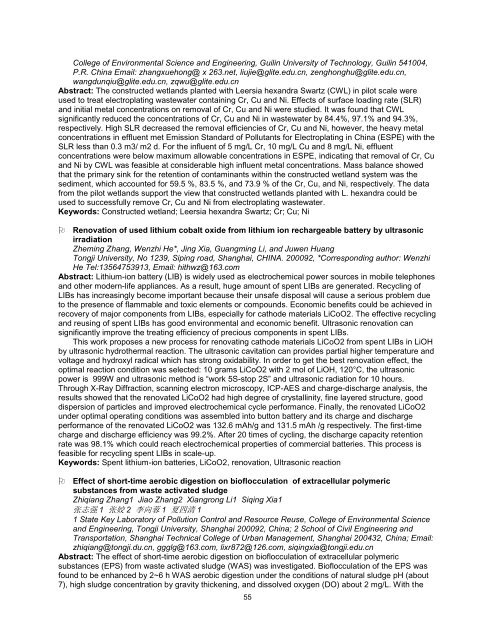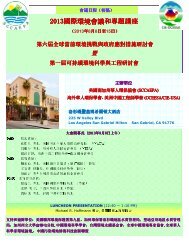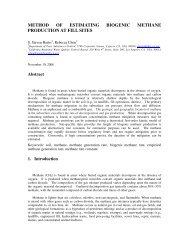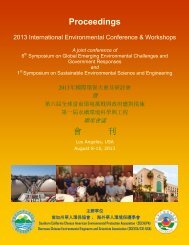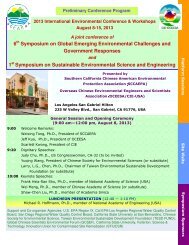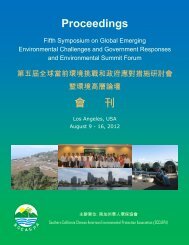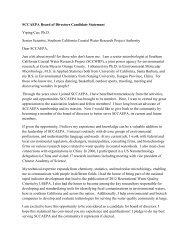Proceedings æ å - SCCAEPA SPONSORS
Proceedings æ å - SCCAEPA SPONSORS
Proceedings æ å - SCCAEPA SPONSORS
Create successful ePaper yourself
Turn your PDF publications into a flip-book with our unique Google optimized e-Paper software.
College of Environmental Science and Engineering, Guilin University of Technology, Guilin 541004,<br />
P.R. China Email: zhangxuehong@ x 263.net, liujie@glite.edu.cn, zenghonghu@glite.edu.cn,<br />
wangdunqiu@glite.edu.cn, zqwu@glite.edu.cn<br />
Abstract: The constructed wetlands planted with Leersia hexandra Swartz (CWL) in pilot scale were<br />
used to treat electroplating wastewater containing Cr, Cu and Ni. Effects of surface loading rate (SLR)<br />
and initial metal concentrations on removal of Cr, Cu and Ni were studied. It was found that CWL<br />
significantly reduced the concentrations of Cr, Cu and Ni in wastewater by 84.4%, 97.1% and 94.3%,<br />
respectively. High SLR decreased the removal efficiencies of Cr, Cu and Ni, however, the heavy metal<br />
concentrations in effluent met Emission Standard of Pollutants for Electroplating in China (ESPE) with the<br />
SLR less than 0.3 m3/ m2 d. For the influent of 5 mg/L Cr, 10 mg/L Cu and 8 mg/L Ni, effluent<br />
concentrations were below maximum allowable concentrations in ESPE, indicating that removal of Cr, Cu<br />
and Ni by CWL was feasible at considerable high influent metal concentrations. Mass balance showed<br />
that the primary sink for the retention of contaminants within the constructed wetland system was the<br />
sediment, which accounted for 59.5 %, 83.5 %, and 73.9 % of the Cr, Cu, and Ni, respectively. The data<br />
from the pilot wetlands support the view that constructed wetlands planted with L. hexandra could be<br />
used to successfully remove Cr, Cu and Ni from electroplating wastewater.<br />
Keywords: Constructed wetland; Leersia hexandra Swartz; Cr; Cu; Ni<br />
Renovation of used lithium cobalt oxide from lithium ion rechargeable battery by ultrasonic<br />
irradiation<br />
Zheming Zhang, Wenzhi He*, Jing Xia, Guangming Li, and Juwen Huang<br />
Tongji University, No 1239, Siping road, Shanghai, CHINA. 200092, *Corresponding author: Wenzhi<br />
He Tel:13564753913, Email: hithwz@163.com<br />
Abstract: Lithium-ion battery (LIB) is widely used as electrochemical power sources in mobile telephones<br />
and other modern-life appliances. As a result, huge amount of spent LIBs are generated. Recycling of<br />
LIBs has increasingly become important because their unsafe disposal will cause a serious problem due<br />
to the presence of flammable and toxic elements or compounds. Economic benefits could be achieved in<br />
recovery of major components from LIBs, especially for cathode materials LiCoO2. The effective recycling<br />
and reusing of spent LIBs has good environmental and economic benefit. Ultrasonic renovation can<br />
significantly improve the treating efficiency of precious components in spent LIBs.<br />
This work proposes a new process for renovating cathode materials LiCoO2 from spent LIBs in LiOH<br />
by ultrasonic hydrothermal reaction. The ultrasonic cavitation can provides partial higher temperature and<br />
voltage and hydroxyl radical which has strong oxidability. In order to get the best renovation effect, the<br />
optimal reaction condition was selected: 10 grams LiCoO2 with 2 mol of LiOH, 120°C, the ultrasonic<br />
power is 999W and ultrasonic method is “work 5S-stop 2S” and ultrasonic radiation for 10 hours.<br />
Through X-Ray Diffraction, scanning electron microscopy, ICP-AES and charge-discharge analysis, the<br />
results showed that the renovated LiCoO2 had high degree of crystallinity, fine layered structure, good<br />
dispersion of particles and improved electrochemical cycle performance. Finally, the renovated LiCoO2<br />
under optimal operating conditions was assembled into button battery and its charge and discharge<br />
performance of the renovated LiCoO2 was 132.6 mAh/g and 131.5 mAh /g respectively. The first-time<br />
charge and discharge efficiency was 99.2%. After 20 times of cycling, the discharge capacity retention<br />
rate was 98.1% which could reach electrochemical properties of commercial batteries. This process is<br />
feasible for recycling spent LIBs in scale-up.<br />
Keywords: Spent lithium-ion batteries, LiCoO2, renovation, Ultrasonic reaction<br />
Effect of short-time aerobic digestion on bioflocculation of extracellular polymeric<br />
substances from waste activated sludge<br />
Zhiqiang Zhang1 Jiao Zhang2 Xiangrong Li1 Siqing Xia1<br />
张 志 强 1 张 姣 2 李 向 蓉 1 夏 四 清 1<br />
1 State Key Laboratory of Pollution Control and Resource Reuse, College of Environmental Science<br />
and Engineering, Tongji University, Shanghai 200092, China; 2 School of Civil Engineering and<br />
Transportation, Shanghai Technical College of Urban Management, Shanghai 200432, China; Email:<br />
zhiqiang@tongji.du.cn, ggglg@163.com, lixr872@126.com, siqingxia@tongji.edu.cn<br />
Abstract: The effect of short-time aerobic digestion on bioflocculation of extracellular polymeric<br />
substances (EPS) from waste activated sludge (WAS) was investigated. Bioflocculation of the EPS was<br />
found to be enhanced by 2~6 h WAS aerobic digestion under the conditions of natural sludge pH (about<br />
7), high sludge concentration by gravity thickening, and dissolved oxygen (DO) about 2 mg/L. With the<br />
55


